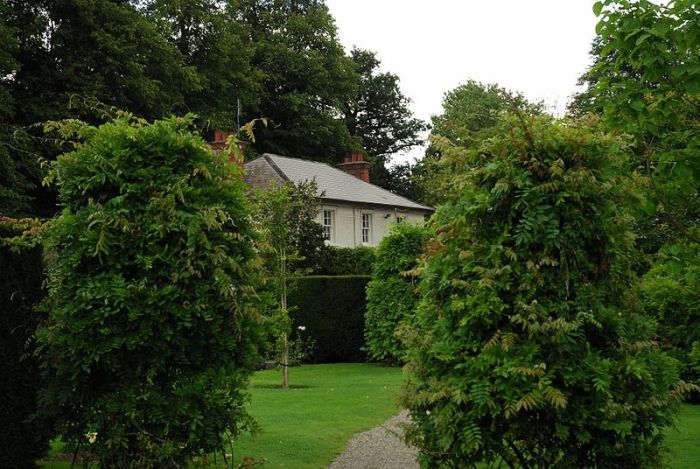
Stewards Lodge on the grounds of the Farmleigh Estate, the Phoenix Park, Dublin.Source: Wikipedia/
By Mary C. Murphy, University College Cork *
Unlike many other countries around the world, the Irish state does not provide an official residence for its Head of Government. Recently however, it was revealed that current Taoiseach Leo Varadkar and his partner Dr Matthew Barrett have been staying in the state-owned Steward’s Lodge on the grounds of the Farmleigh Estate in the Phoenix Park.
The Taoiseach has chosen to base himself in the Lodge during the Covid-19 crisis because it provides him with secure access to video-conferencing facilities and means that he is closer to Government Buildings and Leinster House. For the privilege of temporarily staying there, the Taoiseach is paying rent at a rate of €50 per night.
This arrangement, however, is decidedly unusual when compared with the living arrangements provided for other national leaders by their respective states. In many countries, the Prime Minister and/or President lives in an official state residence during his/her tenure.
President Donald Trump has the White House. Prime Minister Boris Johnson has No. 10 Downing Street. President Emmanuel Macron has the Élysée Palace. The German Chancellor normally lives in the German Chancellery, or to be more specific in the top floor apartment of that building. (The current incumbent Angela Merkel, however, has chosen not to avail of the state facility).
A number of countries even provide two separate residences for their leaders. The British Prime Minister’s country retreat is Chequers; the US President has the use of Camp David. The US also provides an official residence for the Vice President and his family in Number One Observatory Circle on the grounds of the US Naval Observatory in Washington DC.
Smaller countries provide housing for their political leaders too. The New Zealand Prime Minister Jacinta Arden has been residing in Premier House, Wellington, since her election as Prime Minister in 2017. The Hôtel de Bourgogne is the official residence and workplace of the Luxembourg Prime Minister. In Ireland, Áras an Uachtaráin serves as both residence and official office for the President of Ireland.
The majority of these buildings tend to have this dual function: residence and official office. The premier and his/her family live in a part of the building, and the day-to-day business of government/state is carried out in a separate part of the building. The facilities are invariably tailored to support high level security arrangements and they also include domestic and house-keeping services.
Some of these buildings are exceptionally opulent. The exquisite Élysée Palace in the centre of Paris has been the official home and office of French Presidents since 1873. It is an architectural masterpiece boasting 365 rooms and an interior of gold, gilt and priceless artefacts. The stunning building serves a number of purposes which includes not just housing the President and his family, but also diplomatic, ceremonial and state functions.
And it’s not just Presidents and Prime Ministers who are provided with accommodation by their state. The beautiful Villa Spada in Rome houses the Irish Embassy and is also the official residence of the Ambassador. The Irish Ambassador to the US resides at 2244 S Street NW in Washington DC in a house historically named the Frederic Delano House.
Despite providing residences for its Ambassadors overseas, Ireland has never had an official residence for its Taoiseach. There have, however, been attempts to provide such a facility. In 1979 an international architectural competition was held to design an official residence for the holder of the office of Taoiseach and a State guest house to accommodate visiting Heads of State and other dignitaries. The proposed site was the Under Secretary’s Lodge in the Phoenix Park which later became the Papal Nunciature, and today is the Phoenix Park Visitor Centre.
The ambitious project however, never came to fruition. In December 1979, Charles Haughey replaced Jack Lynch as Taoiseach and swiftly shelved plans for the new state residence due to a worsening economic situation.
In 2005, following the refurbishment of the Steward’s Lodge in the Phoenix Park, there were tentative plans for the building to provide a suitable residence for the Taoiseach. Although this has not formally transpired, according to the Office of Public Works, Steward’s Lodge is ‘for the sole use of the Taoiseach when he or she requires overnight facilities in Dublin or for meetings’. Former Taoiseach Brian Cowen did stay in Steward’s Lodge quite regularly while he was in office, and Enda Kenny also used the house, but not as frequently as his predecessor.
In many countries around the world, providing a suitable residence for the Prime Minister and/or President is invariably viewed as both legitimate and normal. Regardless of their grandeur (or not), an official residence is also synonymous with its respective leader and a symbol of national power.
Having access to a secure facility which is specifically tailored to facilitate the needs of the premier (and his/her family), and to simultaneously serve the business of state is judged a wise investment by many countries around the world.
Given the absence of objection to Taoiseach Leo Varadkar’s current sojourn at the Steward’s Lodge in the Phoenix Park, there may be an opportunity to normalise this arrangement for the next and future Taoisigh, and to provide the Head of Government with official accommodation which better supports his/her role and responsibilities as the leader of the Irish state.
Steward’s Lodge, Farmleigh House (the state’s official guest house) and the wider Farmleigh Estate in the Phoenix Park are important state assets, but their under-use has been queried. Collectively however, they have the capacity to serve important practical, political, ceremonial and symbolic functions which simultaneously facilitate the business of government, but also publicly celebrate and showcase the best of the Irish state.

